Infrared thermography of inkjet ink absorption in thin porous media (MSc)
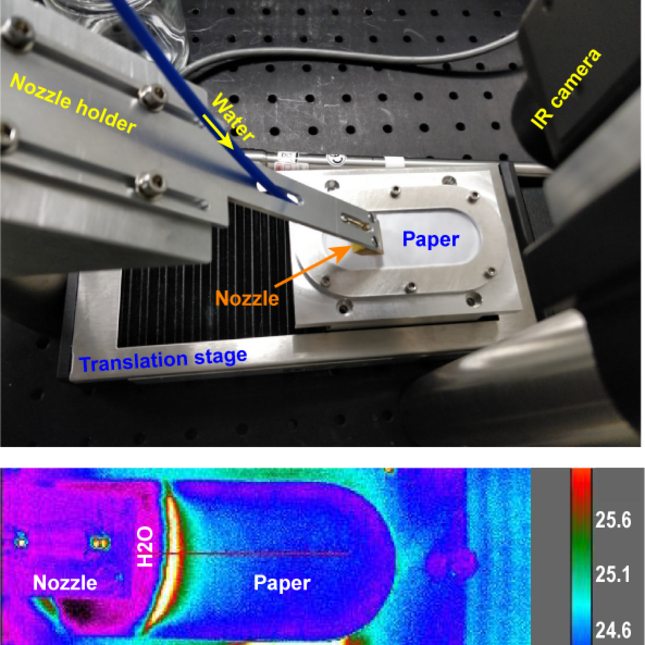
In collaboration with Canon-Océ R&D (Venlo) we are studying the imbibition of water and printing inks into paper. Since paper is optically intransparent, one cannot “look” inside paper with a camera or microscope. Therefore, we are using infrared thermography to indirectly characterize the imbibition dynamics. The figure shows the experimental setup, where paper is moved into a wet zone at a constant speed using a translation stage and the corresponding temperature map is recorded with an IR camera. The goal of the project specifically is to determine how much faster or slower the imbibition process will become when soap-like chemical compounds (so-called surfactants) as well as co-solvents (such as glycerol) and colorants are present in the liquid. The project involves both experiments (approximately 2/3 of the available time) and numerical simulations (approx. 1/3).
Contact: Anton Darhuber
Living liquid drops: how bacteria interact with wet environments (MSc)
Surfaces around us easily get contaminated by droplets that contain bacteria. In this MSc project we aim to understand the interaction between droplets of actively swimming and multiplying bacteria and the underlying substrate. For example, we will investigate how motile bacteria interact with evaporation-driven capillary flows, how bacteria self-assemble and form patterns during evaporation and how bacteria interact with micropatterned substrates. To this end, we will employ (micro)PTV and microscopy techniques with different types of fluorescently labelled bacteria.
Contact: Hanneke Gelderblom and Federico Toschi
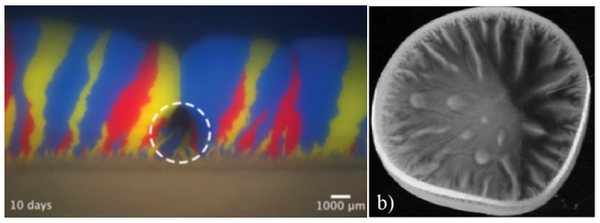
Capillary shaping of collagen patterns for cell guidance (BSc)
Cell polarity and migration in e.g. tendons and ligaments can be steered by the orientation of the collagen fibers surrounding the cell. In this experimental BEP project our goal is to create a substrate with a gradient in collagen density and orientation that allows to study cell migration in vitro. As direct manipulation of the collagen density and/or orientation is impossible, we will make use of evaporation-driven self-assembly to create these substrates. The project is carried out in close collaboration with the orthopaedic biomechanics group at the department of biomedical engineering.
Hanneke Gelderblom and Jasper Foolen
Contact: Hanneke Gelderblom
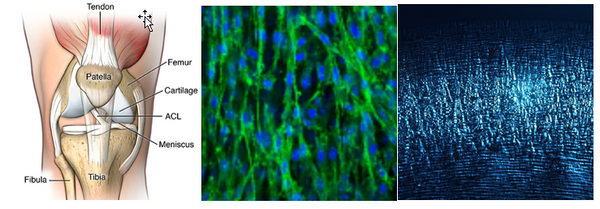
Capacitive tomography of water distributions (BSc)
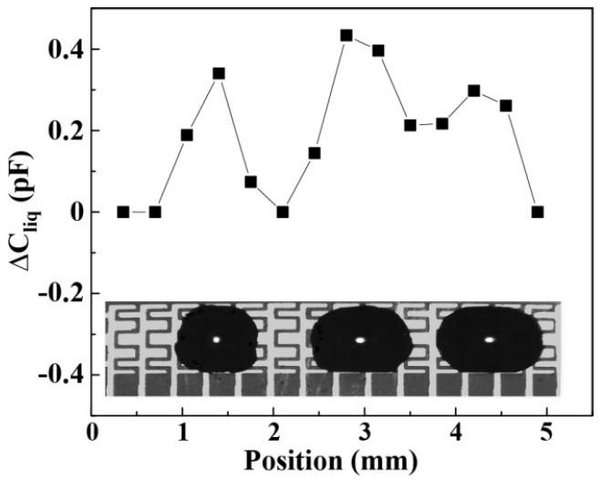
The mutual capacitance of two electrodes depends on the dielectric constant of the medium in between them. The dielectric constant of water is much higher than that of most other liquids. Thus, the distribution of water can be determined by capacitive tomography, even if the water resides inside an inaccessible region such as a porous medium or a closed container. The goal of the project is to first calibrate the method using known water distributions such as droplets on surfaces, and to start with 2D tomography, before 3D tomography is attempted. Numerical calculations using Comsol Multiphysics will aid in the interpretation of the capacitive signal. The figure shows an example of capacitive position determination of droplets using an electrode array and a hand-soldered electronic circuit.
Contact: Anton Darhuber
Wettability modification (BSc)
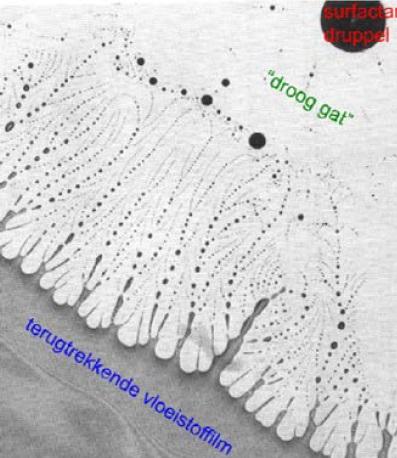
When soap-like chemical compounds (“surfactants”) get in contact with thin liquid layers, a “hole” (i.e. a dry spot) can appear in the liquid layer. If the surfactant molecules have an attractive interaction with the substrate surface, then the dry spot grows in a circular fashion at first, but at some point liquid lines and droplets are left behind inside the dry spot (see figure). It is currently unknown, which mechanism(s) determine this critical radius, as well as the size and distance of the residual droplets. The goal of the project is to do a series of experiments, where the important parameters (film thickness, surfactant concentration and volume, substrate and surfactant materials) are systematically varied and their impact on the system behavior is studied. The experimental methods to be used are optical interferometry and/or -absorption.
Relevant technology and application areas:
- Oil recovery (industrial partner Shell)
- Pulmonary drug delivery - interaction of aerosol droplets with the waterfilm in our lungs
- Inkjet printing (industrial partner Océ)
Contact: Anton Darhuber
Direct assembly of ellipsoidal Janus particles at a droplet interface (BSc)
Particle self-assembly is an ideal mechanism for constructing micro-and nanostructures at scales where direct manipulation is impossible. This technique has many possible applications in the printing industry, to create new kinds of electronic devices or devices for medical applications. However, predicting and controlling the exact properties of the assembled structures remains a challenge and central goal. In this project you will investigate the controllable self-assembly of ellipsoidal Janus colloidal particles with state of the art computer simulations. You will work at the boundary between physics, chemistry, material sciences and computer sciences and gain insight into the current state of research in this field.
In the picture below, an example of externally controlled deposition by means of magnetic fields is shown.
Contact: Qingguang Xie

Laser-induced gas-fluid-solid interaction (BSc)
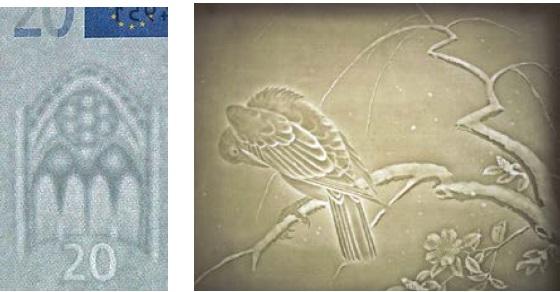
Watermarks are used in e.g. banknotes to safeguard the authenticity of documents but also for artistic purposes (see Figure). Traditionally, a watermark was made by impressing a water-coated metal stamp onto the paper during manufacturing. This embossing locally compresses the paper fibres, reducing their thickness in that area. Because the patterned portion of a page is thinner, it transmits more light and therefore has a lighter appearance than the surrounding paper.
The goal of this project is to investigate the use of an infrared laser beam to locally accelerate the drying of wet paper. A high drying rate may lead to a compactification similar to the above-mentioned stamping process or the local temperature increase may modify the fiber properties. In any case this technique allows to produce paper with spatially patterned properties such as permeability to light and fluid flow. Moreover, if the paper is suspended in air during processing, the laser drying may lead to morphological distortions (“wrinkles”). The goals of the project are to determine the change in properties after laser processing and to evaluate whether the distortions can be controlled in an artistically appealing and/or technologically useful fashion.
Contact: Anton Darhuber
Capillary shaping of collagen patterns for cell guidance (MSc project)
Cell polarity and migration in e.g. tendons and ligaments can be steered by the orientation of the collagen fibers surrounding the cell. In this experimental MSc project our goal is to create a substrate with a gradient in collagen density and orientation that allows to study cell migration in vitro. As direct manipulation of the collagen density and/or orientation is impossible, we will make use of evaporation-driven self-assembly to create these substrates. We will investigate the physics behind this collagen self-assembly as well as the subsequent cell migration on these substrates. The project is carried out in close collaboration with the orthopaedic biomechanics group at the department of biomedical engineering.
Advisors: Hanneke Gelderblom and Jasper Foolen
Contact: Hanneke Gelderblom
